Toyota Prius (2001)
|
Toyota Prius(2001) |
|
|
Short answer: The Prius is great. It's a breakthrough vehicle. It provides a significant increase in gas mileage with almost no penalty to the consumer. It's a tree-hugger's dream that anyone could be happy with. 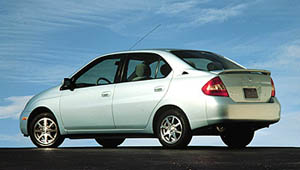 On its surface, the Toyota Prius looks like just another boring and reliable Toyota sedan. But, in fact, it's much more. The Prius is the first of what we suspect will be many new vehicles to use a hybrid, gasoline-electric powertrain. Here's how it works in the Prius. When you start from a dead stop, the electric motor powers the car. Permanent Magnet ACmotors/generators provide excellent torque, so they're perfectly suited to get you off the line. When you reach about 15 miles per hour under normal acceleration, or when you step on the gas for hard acceleration, the four-cylinder gasoline engine kicks in -- seamlessly -- and takes you to whatever speed you want to attain. At highway speeds, the Prius runs entirely on the engine, unless additional power is needed, in which case the electric motor kicks in to add additional power for passing or hill climbing. But you never have to think about it; it's all computer controlled. And you never have to plug it in to recharge it. You get outstanding gas mileage, perfectly reasonable performance, and enough interior room for four adults. And there's next to nothing in the way of emissions. According to the feds, the Prius is a "super ultra-low-emission vehicle," which means it emits 75 percent less pollution than most other cars on the road. With a cars.com target price of $21,600, the Prius is also within the range of most car buyers. As of this review, the Prius is the only hybrid sedan offered for sale in the United States. In fact, there's only one other hybrid for sale as of this writing -- the Honda Insight. The Insight, while offering even better gas mileage, makes too many compromises, in our opinion: comfort is not particularly good, and there's room for only two passengers. (Look for a review of the Insight coming soon.) |
|
 |
Turn the key to the start position on the Prius, and instead of hearing the starter whir until the engine starts, you hear nothing. And, unless the engine is cold, the gas engine remains silent. So how do you know when it's ready to go? Easy: it tells you with a "ready" light on the dashboard.
Once the gasoline engine is warm, the engine will start and stop on its own. At traffic lights, for example, the gasoline engine will simply shut itself off if the batteries are fully charged. When it does run, the gasoline engine also charges the batteries for the electric motor. That's why you never have to plug it in, as you would with electric vehicles. Around town is where the Prius's technology really pays off, because that's when it can rely more on battery power, burning less gasoline and producing less pollution. In fact, the Prius is a bit odd in that it gets better mileage in the city than on the highway. According to the EPA's estimates, it gets 52 miles per gallon in the city and 45 on the highway. By the way, our esteemed producer, Dougie Berman, came up with an excellent question: Could you drive the Prius on battery power alone if you ran out of gas? Unfortunately, Toyota's answer is no. According to Toyota, driving the car without a functioning engine could hurt the battery. The Prius is available only with an automatic, continuously variable transmission. In operation, you may feel the engine revving out of proportion to the acceleration of the car -- kind of like the feeling of a slipping clutch, if you've ever had that experience. It may take a little getting used to, but it works fine. Interestingly, even the brakes on the Prius are used to power the car. In other cars, the friction from braking wastes the energy of motion by turning it into heat. With the Prius, however, some of that energy powers a generator, which helps to charge the batteries. This makes the brakes a little grabby, particularly at low speeds, but we thought we could learn to live with it. The suspension does a good job of combining a comfortable ride with capable handling. The Prius soaks up bumps well and provides good cornering ability. We did find that the power steering in the Prius separated the driver from the feel of the road somewhat. The turning circle is only 34 feet -- a foot smaller than the little Toyota Echo. The Prius is more at home on city streets than the open highway, in our humble opinion. We thought it was a little underpowered and a trifle noisy on the highway, although it certainly felt safe enough. |
 |
How does it achieve this feeling of spaciousness? A wrinkle in the space-time continuum, perhaps? No. The Prius has a tall roof line, much like the Ford Focus and Toyota Echo, which provides extra interior space on a comparatively small wheelbase. Here's the list of options you can get with a Prius: an in-dash CD player and floor mats. That's it. Fortunately, Toyota has equipped this car fairly well, with power windows, locks, and mirrors; antilock brakes; traction control; air conditioning; tilt wheel; and power steering. Cup holders slide out of the center console, which also offers storage space. Storage pockets in the doors and a handful of convenient nooks and crannies for storing your free-range granola round out the amenities. The heater seemed to warm up very quickly and produced a little more heat than we asked for. With the temperature set at 68 degrees, it nearly melted the pomade Mr. Gigi had spent hours applying to Tommy's pompadour. The trunk gives up some of its room for the battery, but not so much as to make it tiny. |
 |
Look through the spokes of the steering wheel, and you'll see... nothing. Well, not exactly nothing. You'll see a nicely padded dashboard but not the gauges and warning lights you might be expecting. Toyota has placed its digital speedometer, odometer, and transmission indicator in a rectangular window in the center of the dash, right below the windshield. Although it's kind of unorthodox, we think it's as good a place as any for them.
The shift lever is a little unusual -- it juts out of the dashboard. The Prius transmission doesn't have a low gear; instead, it has something called "engine braking mode." In this mode, the Prius uses the engine to slow the car down on a steep downhill. The ventilation controls are simple: one switch to direct the air, another to set the temperature, and a third for the fan speed. Stalks hold the usual assortment of headlight and wiper switches, and the window and mirror switches are right where you'd expect them to be. |
 |
|
 |
|
 |
The Prius powertrain is definitely not something with which Vinny at the corner garage should be fiddling. In almost every other respect, however, the Prius is a normal car with many conventional components, such as brake pads, calipers, and CV joints. In fact, if you were looking at the Prius from underneath, you'd be hard pressed to distinguish it from a Toyota Echo. Incidentally, Toyota provides free scheduled maintenance for the first three years. |
 |
View cars.com model report on this vehicle. |
For more information on hybrid vehicles:
|
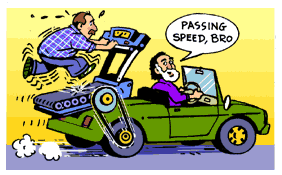
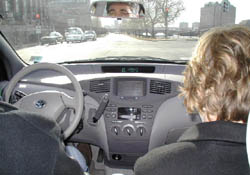 The Prius is a fun car to drive. For all its technology, the Prius acts pretty much like a conventional small car. Turn the key, and the Prius is on. Press the accelerator and it goes. Press the brake pedal and it stops. Yet it does each of those with a slight twist.
The Prius is a fun car to drive. For all its technology, the Prius acts pretty much like a conventional small car. Turn the key, and the Prius is on. Press the accelerator and it goes. Press the brake pedal and it stops. Yet it does each of those with a slight twist.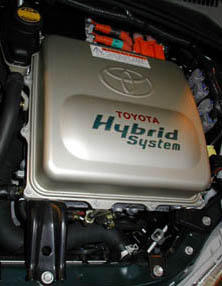 The Prius has both a 70-horsepower, four-cylinder gasoline engine and a 44-horsepower electric motor. One or the other -- or both -- power the car, depending on what kind of driving you're doing. Around town, in start-and-stop traffic, the Prius is powered primarily by an electric motor, which gets its power from a large battery in the trunk. As you speed up, or if you mash the gas pedal down, the gas engine kicks in. When the engine does start, however, there's no great fanfare -- just a very soft purr. You really have to be paying attention to notice it.
The Prius has both a 70-horsepower, four-cylinder gasoline engine and a 44-horsepower electric motor. One or the other -- or both -- power the car, depending on what kind of driving you're doing. Around town, in start-and-stop traffic, the Prius is powered primarily by an electric motor, which gets its power from a large battery in the trunk. As you speed up, or if you mash the gas pedal down, the gas engine kicks in. When the engine does start, however, there's no great fanfare -- just a very soft purr. You really have to be paying attention to notice it.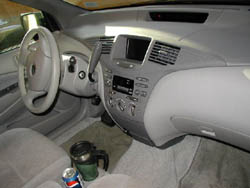 Inside, the Prius has nearly the spaciousness of a Camry. Even though it's a foot and a half shorter than the Camry, it's within an inch of the Camry in front and rear legroom, making it feel quite roomy for such a little car. The front seat has plenty of room, and the back isn't too bad either.
Inside, the Prius has nearly the spaciousness of a Camry. Even though it's a foot and a half shorter than the Camry, it's within an inch of the Camry in front and rear legroom, making it feel quite roomy for such a little car. The front seat has plenty of room, and the back isn't too bad either.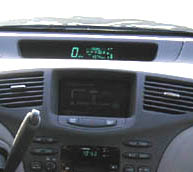 Below that, in the middle of the dash, is something we liked much less: a touch-sensitive video screen that contains the radio controls and an information screen showing whether you're running on battery power or gas. In our humble opinion, these screens are a remarkably stupid idea, because they force you to look away from the road while you're driving -- something that strikes us as inadvisable, as it could distract you from the looming jackknifed plutonium tanker up ahead.
Below that, in the middle of the dash, is something we liked much less: a touch-sensitive video screen that contains the radio controls and an information screen showing whether you're running on battery power or gas. In our humble opinion, these screens are a remarkably stupid idea, because they force you to look away from the road while you're driving -- something that strikes us as inadvisable, as it could distract you from the looming jackknifed plutonium tanker up ahead.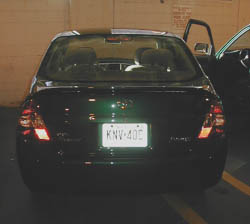 The Prius doesn't qualify as a head-turner in our book, but then, in a small car, that's not such a priority. It's got some of the slightly edgy look of the smaller Echo. But it has better proportions, so it doesn't look as strange. We don't think anybody will buy this car or NOT buy this car based on its looks.
The Prius doesn't qualify as a head-turner in our book, but then, in a small car, that's not such a priority. It's got some of the slightly edgy look of the smaller Echo. But it has better proportions, so it doesn't look as strange. We don't think anybody will buy this car or NOT buy this car based on its looks.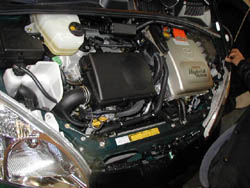 Our jaws dropped when we popped open the hood. There's a heck of a lot of stuff under there. Who knows whether all of this technology is going to be reliable? Furthermore, we have heard some anecdotal information that some of the battery packs in the Prius might be prone to failure. You may find some solace in Toyota's exemplary reliability and the eight-year, 100,000-mile warranty provided for the powertrain and batteries. Also of some comfort should be the fact that Toyota has been selling this car in Japan for the past couple of years. Still, don't delude yourself: There's no doubt that buying a vehicle such as this places you squarely among the ranks of the hybrid pioneers.
Our jaws dropped when we popped open the hood. There's a heck of a lot of stuff under there. Who knows whether all of this technology is going to be reliable? Furthermore, we have heard some anecdotal information that some of the battery packs in the Prius might be prone to failure. You may find some solace in Toyota's exemplary reliability and the eight-year, 100,000-mile warranty provided for the powertrain and batteries. Also of some comfort should be the fact that Toyota has been selling this car in Japan for the past couple of years. Still, don't delude yourself: There's no doubt that buying a vehicle such as this places you squarely among the ranks of the hybrid pioneers.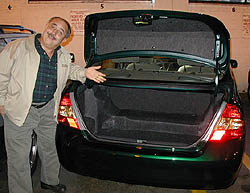 If you like the idea of being an eco-warrior but would prefer not to drive a $40,000 electric car that has a range of 50 miles and a top speed of 35, the Prius is just your ticket. In fact, if you just want a good little car, but also like the idea of doing your part for the environment, go out and buy a Prius. There are really no compromises with this car. You can have your free-range tofu and eat it too. Toyota has done a great job with the Prius. And at a Toyota-subsidized price of $21,600, it almost qualifies as a bargain.
If you like the idea of being an eco-warrior but would prefer not to drive a $40,000 electric car that has a range of 50 miles and a top speed of 35, the Prius is just your ticket. In fact, if you just want a good little car, but also like the idea of doing your part for the environment, go out and buy a Prius. There are really no compromises with this car. You can have your free-range tofu and eat it too. Toyota has done a great job with the Prius. And at a Toyota-subsidized price of $21,600, it almost qualifies as a bargain.